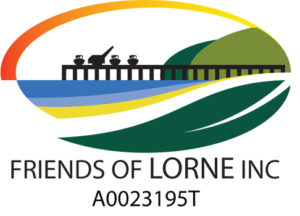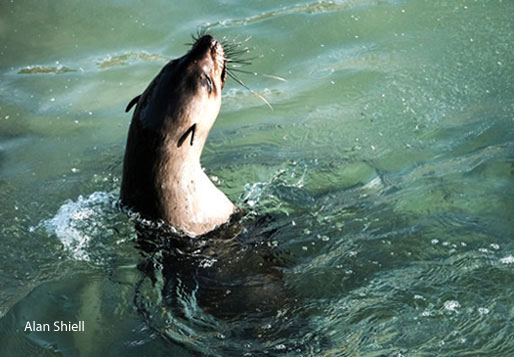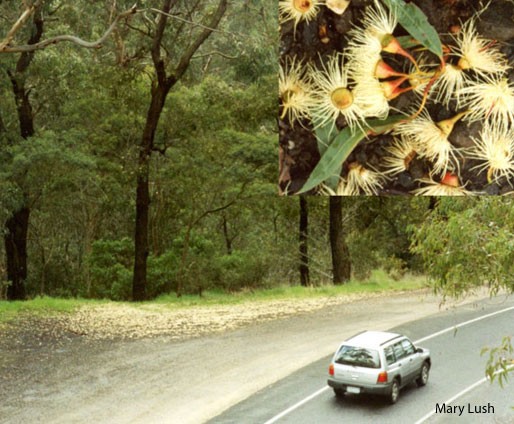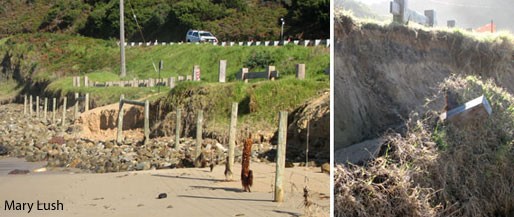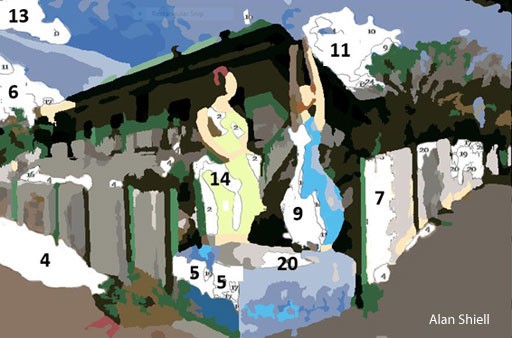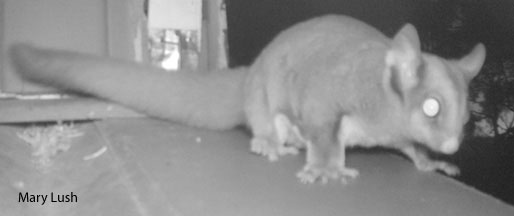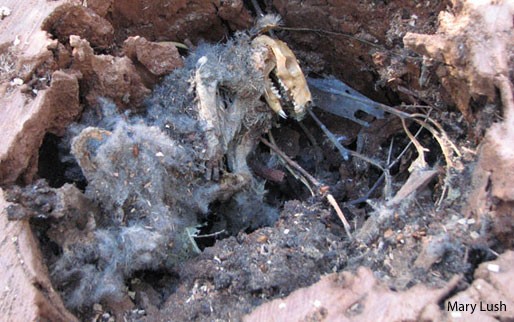|
|
||
|
In a year full of ‘unprecedented’ events it comes as something of a relief to experience natural events that have plenty of precedents.
One such event is the opportunity to watch a seal displaying its water aerobic skills at the pier. It is particularly good at doing rolls. At the time of writing it is conducting daily displays. |
||
|
A little further afield, another event is the flowering of the ironbarks along the Great Ocean Road at Grassy Creek. They are carpeting the ground with flowers. It’s worth doing one of the walks from the Distillery Creek Picnic Area near Aireys Inlet to see the ironbarks and hear the birds feeding in them (the birds are surprisingly hard to see). |
||
|
And a few bends further along the road, the boat ramp at the Lorne end of Eastern View (Spout Creek) has done its usual winter disappearing act, along with an undermined bollard or two. Coasts all over the world experience cycles of sand erosion in winter followed by deposition in summer, but Eastern View is in an erosion spiral rather than a cycle. Each year more sand is lost than is replaced, making it increasingly rocky. It’s not natural processes that rebuild the ramp each summer – it’s the Great Ocean Road Coastal Committee (GORCC). |
||
Annual subscriptions 2020/2021 |
||
|
A reminder to members of the Friends of Lorne that their subscriptions are due. The renewal form is HERE The application form for new members, who are most welcome, is HERE We have set up a ‘fillable form’ for use this year. It is not yet perfect. Let us know if you have problems. You can also print the form and return it by conventional mail. |
||
Planning and other matters |
||
Lorne – A Place of Special Significance and Natural Beauty |
||
|
An article by Jane Orr in this month’s Lorne Independent is a treat for history buffs and anyone who loves Lorne. Jane describes some of the early history and achievements of Friends of Lorne when we were called the Lorne Planning and Preservation League. The League, with Jane’s grandmother Beverley Orr at the helm, succeeded in having Lorne’s unique character officially recognised in about 1975. The intention behind our State-level designation as a place of ‘Special Significance and Natural Beauty’ was to herald new ways of using town planning to protect and preserve special places such as Lorne. It led to a generous grant to develop the first Lorne Foreshore Plan. Friends of Lorne is still working to protect the natural environment while respecting the needs of full- and part time residents and visitors, as readers can see in the articles in this newsletter. Read Jane’s article HERE |
||
Point Grey (pier area) – DECISION MADE |
||
|
The Surf Coast Shire Council decision of 23 June was to issue a permit to GORCC to demolish both the fisheries co-operative and the aquatic club and build according to their plans (subject to some conditions) . The Committee of the Friends of Lorne acknowledges that members have a range of views about the Pt Grey development. Our preferred option for Pt Grey, which we put to Council, was that the fisheries building should be rescued and renovated. We argued that it represented our industrial history and heritage. We also argued that a landmark ‘beacon’ building in its place is not suitable for the site. MORE Our submission is on our website MORE The Council’s decision and notes Some 1527 people signed a petition to oppose demolition of the Fisheries building. It was presented to Parliament in February by local state member Richard Riordan. There is a small window of time to consider next steps – if any. If you have a view, please email us immediately. |
||
Erskine Paddock |
||
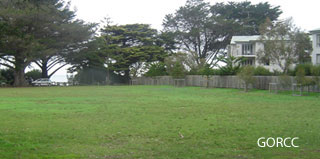 |
||
|
Erskine Paddock is part of the crown land on the foreshore of Lorne between the Mantra and the Swing Bridge. It has a small playground and barbeque area but is otherwise open space. It is occasionally used for public events such as the sculpture exhibition. In 2017 and extending to early 2019, GORCC, the land manager, ran a series of consultations on plans that affect the paddock. The final plan involves replacement of equipment and some modest landscaping and track work. After the end of the last consultation period, some members of the Lorne community attempted to reopen the planning process when they proposed that a looped track for people on wheels (bicycles, roller skates, skateboards etc) be built on Erskine Paddock. Called ‘pump parks’, these tracks are sealed in asphalt or concrete for use in all weathers. The proposed track would occupy most of the open space in Erskine Paddock. GORCC restated its policy that the foreshore should be reserved for uses that are necessarily associated with the foreshore. A pump park was not such a use. The Committee of FoL supports GORCC’s position. We prefer a foreshore that is as natural and undeveloped as possible. We are not opposed to a pump park being constructed in another location if there is a demand for it. The proponents of a pump park continue to lobby for one to be built in Erskine Paddock. MORE on GORCC’s plan |
||
Renewable energy |
||
|
The Friends of Lorne accepts the evidence that our climate is changing and that the changes are at least partly a consequence of the activities of mankind. Renewable energy is a critical part of any attempt to reduce greenhouse emissions. Our efforts to understand the energy options in Lorne led us to the Lorne hospital which installed a large (60 kW) solar system at the end of 2019. MORE information about the performance of the hospital system |
||
‘Lorne by Numbers’ |
||
|
Have you heard the idea that Lorne needs 1500 permanent residents by 2020? Or that unless more visitors stay an extra day, business viability is threatened? Lorne by Numbers is a project to work out exactly what we might need in terms of permanent population, and/or more visitation, or longer stay by holiday owners to retain key assets here like the CFA, the hospital, the SES, the pharmacy, etc. Why does precision matter? Because planning is about protecting the landscape, and balancing liveability and environment. Read MORE about it here. Get involved! This is a whole-of-community ‘citizen science’ project to collect information. We need volunteers. It’s fun. It’s useful. It’s easy. And it’s time-limited (you are not signing on for life!) |
||
Great Ocean Road Coast and Parks Authority (GORCPA) |
||
|
This authority, the aim of which is to bring together the various instrumentalities that manage the coastal strip and public lands associated with the Great Ocean Road, will start functioning on 1 December 2020. MORE (submission from Friends of Lorne) MORE (early opinion on reorganisation from Aireys Inlet District Association (AIDA)) |
||
Natural history note from Mary Lush |
||
|
In my part of Lorne we still have some decrepit old trees. Each year these trees support a breeding pair of mopokes (see end of April newsletter). We also have sugar gliders (shown above, actual size about that of a small rat) and probably much more because it turns out that 17% of Australian birds, 42% of mammals and 28% of reptiles use tree hollows in some way. And that it takes 100+ years for a tree to develop hollows i.e. housing, for native animals. None of this makes me feel good about the fact that my neighbour and I have just cut down (with professional assistance) an old and holey tree that loomed over the neighbour’s house. As work progressed a microbat flew out. It wound up as lunch for a kookaburra. Within the dropped tree, which fortunately for my conscience proved to be very close to collapsing unassisted, was a central hollow that held the remains of a past resident. As in many detective stories, the teeth are key to its identification. It’s a possum.
To return to sugar gliders. Before you try poisoning the ‘rats’ around your Lorne house make sure they aren’t sugar gliders, or antechinus. You will know them from their CHATTER if you are very close to a nest. And if you see them, from their beautiful tails and large, relatively speaking, feet. If you are lucky you might see one volplaning through the air like a miniature flying carpet. This VIDEO shows a loose membrane between the glider’s front and back legs. The glider does a sort of star jump when it takes off thus stretching the membrane out between its legs to form ‘wings’. This SECOND VIDEO shows a glider taking off. |
